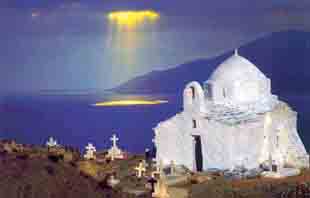

|
RELIGION AND CHURCH Nearly all the Greeks are Greek-orthodox. The difference to the Catholic belief is not very big, for example the Greek-orthodox parsons are allowed to marry as long as they do not attempt to rise in the hierarchy. The most important holidays are not Christmas, but Easter. The Greek Church is a people's church and follows the traditions of the early Christians. There is nothing far away or high above. The relation between priests and believers is like you have relation to your neighbor.
About the religiosity of the Greeks one may discuss. More often you see women in god's house than man, more often elderly people than young ones. Many Greeks, especial the younger, want to escape from the very strong influence the church has. At the one hand the church is accepted as the keeper of the tradition, but at the other hand it is highly criticized about its dogmatism and interfering in daily and private life. The mass is not hold in the today's common used Neo Greek language (Dimotiki), but in that language, which was used in the past only by the scholar classes, the Katharevousa, which was developed from ancient Greek. The mass lasts two time longer than it does e.g. at the Catholics. The priest is supported by two groups of singers. In the back upper part of the church there is the women's balcony. the only place where women had been allowed to participate the mass - nowadays it is history. |
© SCI 2003 - 20XX // all rights reserved
 A big difference is, that the Greek religion does not believe in the infallibility of the pope. The Holy ghost is not sent by Jesus, but by god. There are no taxes, people have to pay, like in so many Central European countries. The church do not get any economical support from the government. Although it is one of the richest institution in the country.
A big difference is, that the Greek religion does not believe in the infallibility of the pope. The Holy ghost is not sent by Jesus, but by god. There are no taxes, people have to pay, like in so many Central European countries. The church do not get any economical support from the government. Although it is one of the richest institution in the country.